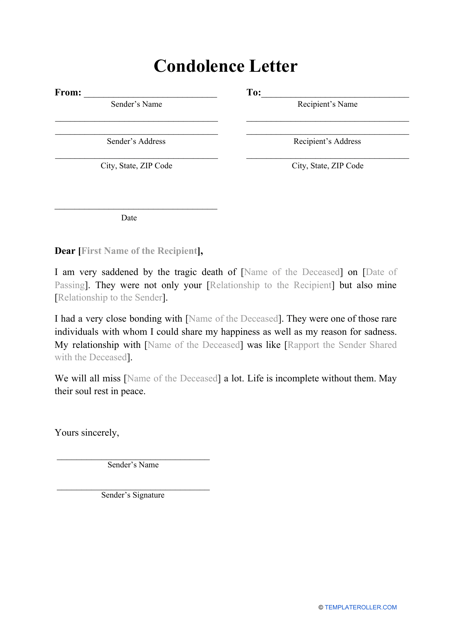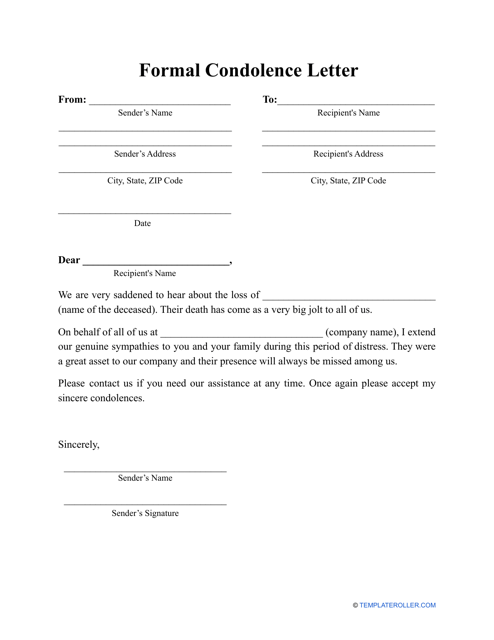Free Sympathy Card Templates
A Sympathy Card is drafted as a sign of respect and support for an individual who has experienced a loss, usually for the death of a loved one.
Alternate Name:
- Condolence Card.
It provides the sender with an opportunity to express their condolences and regret at the death. The card is usually sent straight away after hearing of the news. Although these first few days after a death are usually extremely busy with lots of things to prepare and organize, you should still send it earlier rather than later. The recipient may be too busy to look at it properly, or even process the information. The family usually only really starts to look at these after the funeral when they will be looking for some warmth.
Even if some time has passed, you should still send a Sympathy Card – it demonstrates your goodwill and thoughts about the deceased. If you feel like it is possibly too late to send a card, you still ought to as this will still be appreciated. Avoiding this all together can actually do more damage to the grieving family.
Sometimes, Sympathy Cards are also posted to close friends or family members of the deceased, on days that would have been important for the deceased or their family. It could be an anniversary, their birthday, or even Christmas. This is the first year that these celebrations are marked without their loved one present. It would be a wise idea to support them in such a tough time.
For a full list of Sympathy Card templates please feel free to check out our library below.
What to Write in a Sympathy Card?
Writing a Sympathy Card isn’t the easiest of tasks. You want to ensure that you get the correct tone and message across, particularly during such a hard time. It is very hard to find the right things to say, especially if you are not particularly very good at expressing yourself. You want to avoid sounding patronizing and uncaring but at the same time, may not want to write too much because you are worried it might cause more painful memories.
Although it is tempting to relate the grief to yourself in the Sympathy Card message, you should avoid doing this. Focus on the grieving person and offer them your full support, as opposed to stories of how you have already experienced something like this. Show compassion, be sincere and genuine – this is the most important thing to consider when writing a Sympathy Card. Consider using the structure below when drafting your card:
- Keep your message short and to the point;
- Consider the closeness between you and the deceased when writing the card;
- If you experienced a close relationship with the deceased, but you never had the opportunity to meet the family – you should let them know how you and the deceased were related;
- Show your appreciation of the deceased. Talk about your admiration for them;
- Lend a helping hand and offer them some support. It can be something small from bringing food round/offering to babysit to carrying out some work at their home. What could be a small thing to you, could actually be a big thing for the grieving.
How to Sign a Condolence Card?
When signing a Sympathy Card, you need to use the appropriate tone, reflecting the feelings you want to express. The Sympathy Card closing can be particularly difficult to get right. If you were rather close to the deceased person, you can sign off with ‘Love,’ followed by your name or a nickname that the deceased referred to you by. If you knew of or didn’t know the deceased individual too well, you might opt to use a formal signing off such as:
- Our deepest/most sincere sympathy;
- With caring thoughts.
The closing should summarize your last thoughts and include blessings. Do not worry about saying something wrong – it is the thought that counts in these situations. Your gesture will speak for itself and mean a lot.
How to Address a Sympathy Card?
Again, this all depends on your relationship with the deceased and just how well you knew them. If you knew them personally then you can address your Sympathy Card to a close remaining relative. If they were known to your family or friends, but not you personally, then you should address the card to them.
When posting the card ensure that you fill in the envelope appropriately. Write the full name and title of the recipient, regardless of the closeness of your relationship with them.
Haven't found the template you're looking for? Take a look at the related templates below:
- Retirement Card Template;
- Get Well Soon Card Template;
- Memorial Card Template.
Documents:
7
This Sympathy Card Template in Pink is a printable design that can be used to express condolences and support to someone who has lost a loved one. It features a subtle pink color scheme and can be customized with a personal message.
This document is a template for creating a sympathy card with a rose design.
This template is used for creating a sympathy card with floral design. It is a thoughtful way to express condolences.
A Condolence Letter is a personal document sent to a family member, friend, or colleague of a person who has recently passed away.
This letter can be written for a former employee, business partner, or member of a professional association to formally share your condolences with the individual in question.
This type of document is a template that can be used to create obituary cards, which are small cards that provide information about a person who has passed away. The template typically includes spaces for the person's name, date of birth, date of death, and a brief tribute or message. Obituary cards are often distributed at memorial services or funerals.
This document is a template for a funeral invitation that features floral design elements. It can be used to create personalized invitations for a funeral service.







